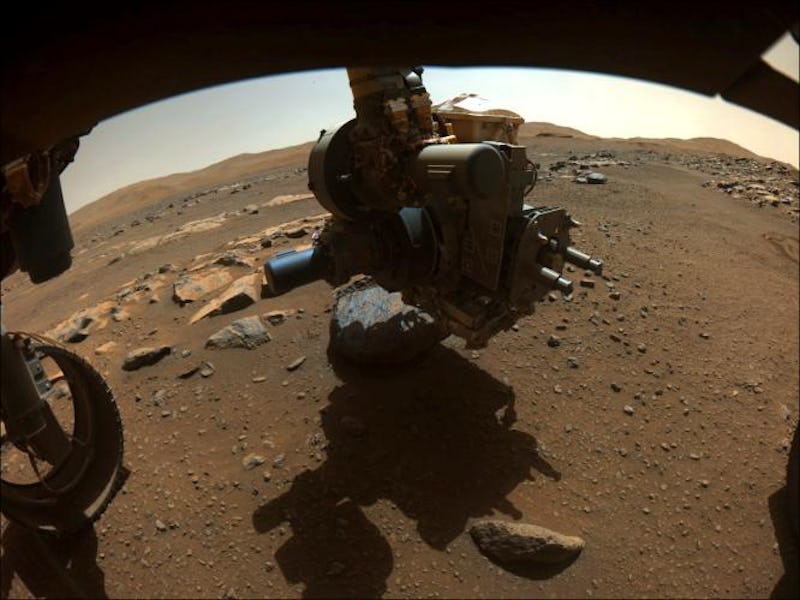Perseverance: Watch the rover look for “bubbles” of life
The rover is drilling its way through Mars, one rock at a time.

After spending more than 200 sols on Mars, NASA’s Perseverance rover finally made a friend.
The car-sized robot collected its first two samples from the Red Planet after drilling through a rock nicknamed Rochette. These chalk-sized samples may hold clues to the universe’s most burning question: Is there life beyond Earth?
That’s one of the overarching goals of the Perseverance mission, which will spend at least one Martian year (around 687 Earth days) roaming Jezero Crater in search of intriguing clues to Mars’ watery past. Around 3 billion years ago, Mars was likely covered in rivers and shallow seas. During that time, it could potentially have had the right conditions for life to arise.
NASA released a series of images showing Rochette the rock before Perseverance drilled into it and after, revealing the two holes where the rover’s drill left a mark.
Perseverance’s science-instrument-laden turret at the end of its robotic arm examines the rock nicknamed Rochette before obtaining two samples.
Using its Wide Angle Topographic Sensor for Operations and eNgineering instrument, or WATSON, the robot photographed this special moment on August 27 as it first got to know Rochette the rock.
Perseverance had just scraped away a circular piece of the rock that the team nicknamed Bellegarde. The patch is about 0.39 inches deep and about 2 inches wide.
But the rover was just getting started.
In order to get the Martian samples, Perseverance drilled two holes in Rochette.
After a few days by Rochette’s side, Perseverance drilled its first hole in the Martian rock on September 1. The hole itself was nicknamed Montdenier, and it produced Perseverance’s first-ever Martian sample.
This marked the rover’s second attempt at collecting a piece of the Red Planet and the first successful one. Earlier in August, Perseverance attempted to collect a sample of Martian rock but ended up pulverizing the sample into tiny bits.
Perseverance collects the samples using a drill attached to the robot's arm.
The samples move through the robot's belly and into the Adaptive Caching Assembly System, where they are sealed in an airtight titanium sample tube.
Perseverance drilled two holes in the same rock it found on Mars, producing two chalk-sized samples for future analysis in an Earthly lab.
On September 7, Perseverance drilled its second hole in Rochette. This time, the hole was nicknamed Montagnac to go along with the theme of places in France.
A closeup of Rochette reveals its battle wounds.
In this close-up image of Rochette, small shavings from the Montdenier hole can be seen after it slid over Bellegarde (the first circular patch).
Rochette the rock is basaltic, which means that it may have formed from lava flows. Crystalline minerals in volcanic rock can help scientists accurately date when the rock formed and could provide a timeline of Mars’ history and how its climate changed billions of years ago.
Rochette sacrificed two pieces of itself to help humanity answer the existential question of whether life exists beyond Earth.
The rock samples also revealed salts, which may have resulted from groundwater flowing through the rocks and altering their composition or liquid water evaporating and leaving its salts behind.
The salt in the rocks could have also trapped tiny bubbles of ancient Martian water that scientists can analyze once the samples make it back to Earth.
“It looks like our first rocks reveal a potentially habitable sustained environment,” Ken Farley, project scientist for the Perseverance mission, said in a statement. “It’s a big deal that the water was there a long time.”
Perseverance carries 43 titanium sample tubes and is supposed to collect at least 20 samples from Mars during its 687 Earth day mission on Mars.
Once it has collected its samples, Perseverance will leave them behind on Mars for that pickup mission planned for sometime in the 2030s. The mission's goal is to bring the Martian samples to Earth, where they can be analyzed in a lab, revealing clues to ancient microbial life that may have lived on Mars during its early history.